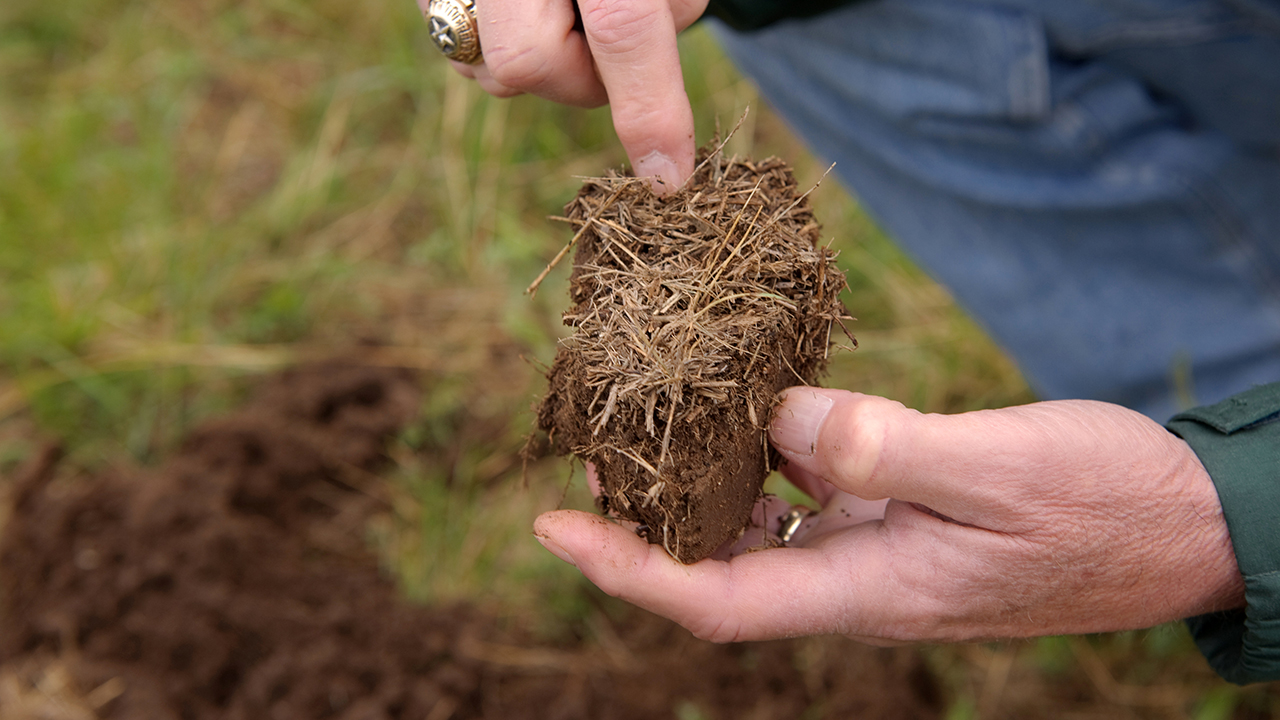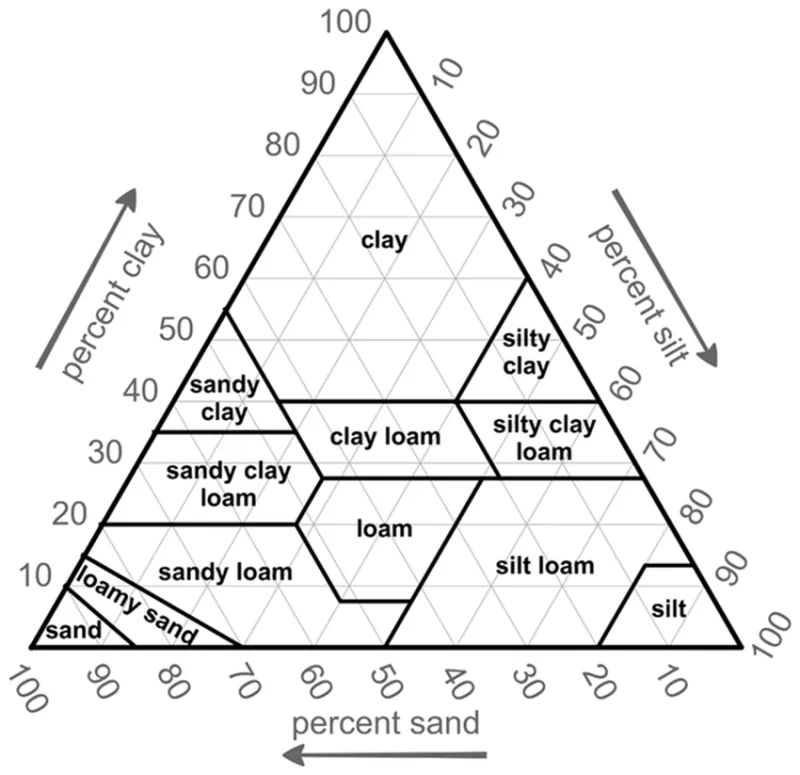Lesson 2 - Soil properties

Soils are made up of physical, chemical and biological properties with each having a role to play in maintaining soil health and sustaining plant growth and performance.
We tend to describe soils using terms such as clay, loam or sand, but what we are really describing is soil texture. Soil texture is determined by the distribution of different mineral particles in the soil, including finer particles like clay and silt, and coarser particles like sand. All soils have different proportions of these in them, leading to different soil texture classes, as the soil texture triangle below illustrates. Thus, we have ‘silty loams’ and ‘sandy clays’ amongst other soil types.

Diggers tip
Take on the role of Dirt Detective, take a look at the soil at the places you visit throughout the week. Note the difference in texture and colour. Take particular note of the soil beneath plants that are thriving.
When we know the soil texture in our garden, we have we can make some judgements about how they will behave. Sandy soil is free-draining, easy to cultivate, and can be difficult to wet when they are very dry. Clay soil by contrast is sticky when wet, heavy, not very free-draining and often waterlogs easily. Loamy-textured soils are different, having proportions of clay, sand and silt in them to varying degrees. They tend to be crumbly when cultivated, especially when they have plentiful organic matter, hold water well, but still drain and are ideal for most growing situations. Soils with a loose, friable texture, able to be easily worked and cultivated are described as having a good tilth. Which in turn facilitate seedling emergence and root growth through the soil. Outcomes that are very useful when growing food plants!
Beyond texture there is another way we can describe a soil and that is how the different mineral particles and organic fractions, particularly humus, are arranged, we call this soil structure. Soils with a good structure have ‘crumbs’ which are aggregates of minerals, humus and pores. When these crumbly soils are cultivated, they break up easily, with plant roots easily accessing water and nutrients held there. By contrast, poorly structured soils often have dense clumps or clods and tend to be difficult to cultivate. They can also form crusts on the surface and will often be poorly drained. Never fear, we can improve soil structure, and you will learn more about that in a later lesson.
Another physical property of soil is colour. The soil colour can indicate how fertile it is and/or how free draining it might be. Darker brown and black colours tend to be in soils that are higher in humus, which will also make them more fertile and better draining. While grey, greenish and mottled coloured soils often indicate poorly aerated and poorly draining soils. The type of parent minerals present will contribute to the overall soil appearance and colour. A good example is the presence of iron oxide compounds which can cause red or reddish-brown colours in soil. However, colour can be misleading so it’s a good idea to examine the soil in its entirety before rushing to judgment – which is why it’s important to do some simple tests.
To grow plants successfully, we need to understand a little about soil chemistry. Plants take up the majority of their nutrients through their roots. The nutrients are present in the soil as mineral compounds produced by weathered rocks and decomposed organic matter. The mineral compounds are made up of specific elements, such as nitrogen, potassium and phosphorus, all essential for plant growth.
Plants need at least 17 different elements, although three of these – carbon, hydrogen and oxygen – are from the air and water. The remaining elements include major elements (6), required by plants in relatively high amounts, and minor elements or trace elements (11), that are required by plants in only small amounts (see table below). These elements in the soil are accessible to plants when they are soluble, so ensuring there is sufficient moisture in the soil is provides more than water to plants, it also provides them with nutrition. Different plants require different amounts of these elements, but growth will be poor if one of them is in short supply.
| Macronutrients | Micronutrients |
| Nitrogen (N) | Iron (Fe) |
| Phosphorus (P) | Manganese (Mn) |
| Potassium (K) | Boron (B) |
| Calcium (Ca) | Molybdenum (Mo) |
| Magnesium (Mg) | Copper (Cu) |
| Sulphur (S) | Zinc (Zn) |
| Chlorine (Cl) | |
| Nickel (N) | |
| Cobalt (Co) | |
| Sodium (Na) | |
| Silicon (Si) |
Nutrient access in soils is also influenced by pH – the relative acidity (low pH) or alkalinity (high pH) of a soil. Scientifically, pH is the concentration of hydrogen ions in a soil but it’s range affects the availability of nutrients, so it is important to know.
The ideal pH in most soils is around 6.5 – because at this point on the scale most nutrients will be balanced and available for plants to access and use. At extremes of pH – such as below 5 (acid) and above 8 (alkaline) – different soil nutrients are more restricted or are in excess – causing problems with plant nutrient uptake and toxicity.
Biological properties are the living parts of a soil. These include microscopic organisms, such as bacteria and fungi, through to larger organisms such as insects and earthworms. These microbes and animals live and die in the soil and contribute to soil health by decomposing organic materials, releasing nutrients for plants to use and improving the structure of the soil.
One soil animal, the earthworm, has an incredibly beneficial effect on soils used for growing food. Earthworms are the ultimate recyclers by consuming organic materials and releasing nutrients for plants to use. Through their movement they also improve soil structure by increasing crumb formation, in turn improving aeration, water-holding and nutrient holding. The key to increasing the number of earthworms in your soil is through additions of organic matter, particularly higher nitrogen sources like compost, kitchen waste and lawn clippings. They like moist soils and moderate temperatures so ensuring a soil is moist and mulched over summer will help build up earthworm numbers in your garden.
Diggers tip
Earth worms and compost worms are different kinds of critters. Earth worms like to live deeper in the soil. Compost worms which are mostly red live closer to the surface.
While a group of soil-borne fungi, mycorrhizae, create a dense network of fungal filaments or hyphae beneath the ground. They live on roots in a symbiotic (mutual beneficial) relationship with their plant hosts. They benefit plants by enhancing water and nutrient uptake and increasing tolerance to stresses like drought, salinity and disease. Most species of mycorrhizae fungi are specific to one group of plants only and reintroducing them to very disturbed sites can be problematic.
Not all living elements in a soil are useful, some may be pests or pathogens – causing damage, disease and even death to plants. Warning signs are unexplained plant deaths, particularly when conditions appear to be otherwise good for growing. The most common pathogens in the soil are ‘damping-off’ fungi that cause the death of seedlings and the roots of some plants. Parasitic nematodes, a type of miniscule worm in the soil, are also problematic as they feed on plant roots and can facilitate the attack by harmful bacteria and fungi as well. Ensuring there is a healthy amount of organic matter in the soil, regularly rotating crops in the same place and avoiding poor drainage can help to avoid these problems. Using disease resistant cultivars of plants will also avoid many common plant pathogens and pests. A healthy soil will always be one with lots of life in it but in some situations, it may be necessary to undertake testing that analyses soil microbial activity and pathogens to determine a course of actions. These are available through different laboratory services in each state.
And while some bacteria can be a problem for plants, some help plants by producing nutrients for them to use. Legumes, such as clover, beans and peas can fix nitrogen from the air through a symbiotic relationship with a bacteria (i.e. Rhizobium sp.). The bacteria form nodules on the plant roots and when these roots die, the nitrogen is released back to the soil.
Further learning
- Soil Properties - Science Learning Hub Pokapū Akoranga Pūtaiao
- Soil Health - Soil Properties - Soil Health Nexus
- How to identify your soil type - Royal Horticultural Society
- Soil types - Royal Horticultural Society
- Soil pH explained - Soil Quality Knowledge Database
- pH and testing soil - Royal Horticultural Society
- Free range worms - Gardening Australia